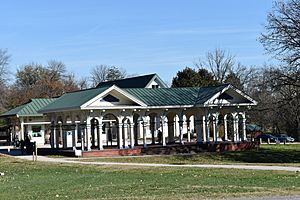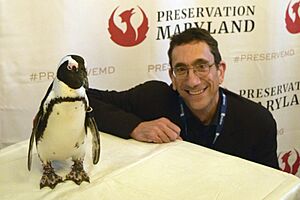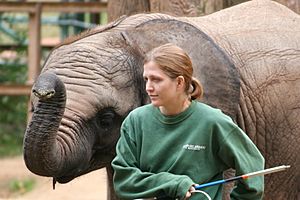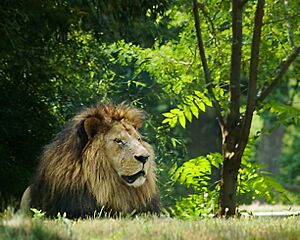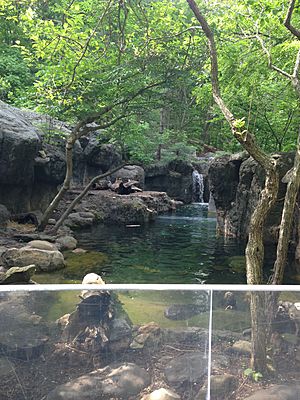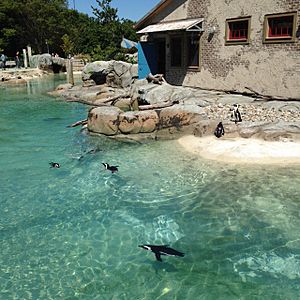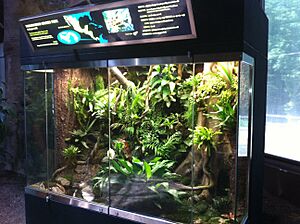The Maryland Zoo in Baltimore facts for kids
 |
|
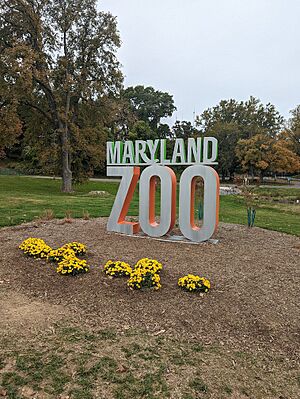
Entrance sign
|
|
| Date opened | 1876 |
|---|---|
| Location | Safari Place, Druid Hill Park, 1876 Mansion House Drive Baltimore, Maryland 21217 United States |
| Land area | 135+ acres |
| Coordinates | 39°19′24″N 76°38′58″W / 39.32333°N 76.64944°W |
| No. of animals | 1,500 |
| No. of species | 200 |
| Annual visitors | 500,000 |
| Memberships | AZA |
| Major exhibits | African Journey, Northern Passage, Maryland Wilderness |
The Maryland Zoo, also known as The Maryland Zoo in Baltimore, is a fun place to visit in Baltimore, Maryland. It covers 135 acres inside Druid Hill Park. This park first opened in 1876. A famous landscaper named Frederick Law Olmsted helped design it. He also designed New York City's famous Central Park.
Today, the Maryland Zoo is home to over 1,500 animals. It is approved by the Association of Zoos and Aquariums (AZA), which means it meets high standards for animal care.
Contents
History of the Zoo
The Maryland Zoo in Baltimore is one of the oldest zoos in the United States. It opened in 1876. A man named Henry Bishop, known as the "Bird Man," helped start the zoo. He gave many animals to begin the zoo's collection.
For many years, the city of Baltimore managed the zoo. Later, a group of friends and animal lovers formed the Baltimore City Zoological Society. This group helped protect the animals and visitors by adding a fence and ticket gates around the zoo.
In 2004, the zoo became a more independent organization. It started getting money from private groups, the state, and nearby counties. This change also led to the zoo being renamed "The Maryland Zoo in Baltimore."
From the 1950s to the 1970s, Dr. Arthur Watson, the zoo director, made the zoo famous through television shows. In 1980, when the Harborplace market opened in downtown Baltimore, Dr. Watson even had a store there called "Dr. Watson's Zoo" that sold stuffed animals.
In 2004, the zoo faced money problems. It had to temporarily close some parts and send some animals to other zoos. These animals included reptiles, gibbons, tigers, and snow leopards. By 2008, the Maryland Zoo was even featured in a book called "America's Best Zoos 2008."
On September 28, 2021, the zoo reopened its original Main Valley as a walking path. This path shows the zoo's history and old landmarks. While some birds still live in the updated Crane Barn, the old animal cages are not used anymore. The zoo is planning for the future to bring animals back to the Main Valley in new ways.
On August 23, 2022, the Zoo shared a ten-year plan. This plan aims to make the visitor experience even better and create new homes for the animals.
Zoo Exhibits
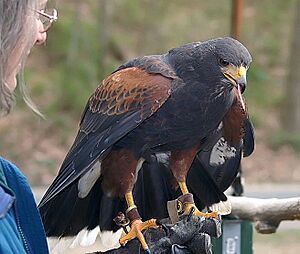
The Maryland Zoo has five main areas: Schaefer Plaza, Zoo Central, Maryland Wilderness, Northern Passage, and African Journey. When you visit, you enter through Schaefer Plaza. This area has a gift shop, a playground called "Celebration Hill," and an exhibit for black-tailed prairie dogs.
You can walk down the historic "Main Valley" to reach the exhibits. The animal homes in the Main Valley are currently empty. A free shuttle can also take you to Zoo Central. At Zoo Central, you'll find places to eat, a carousel, and a children's train ride.
The zoo train takes you on a one-mile trip through parts of the zoo. It even crosses a 105-foot bridge! The current train, from 2010, looks like an old 1863 locomotive.
African Journey
"The African Journey" is the biggest part of the zoo. It shows many animals from Africa. Here are some of the main areas:
- African Aviary: This is a walk-through area where you can see birds like the blue-bellied roller and African spoonbill.
- African Watering Hole: This area looks like a watering hole. You can see animals like dama gazelles, white rhinoceroses, plains zebras, and ostriches. You might also spot Caribbean flamingos and Cheetahs nearby.
- African Overlook: This is where you can see the lions and giraffes. Warthogs are also close by.
- Chimpanzee Forest: This area has indoor and outdoor spaces for chimpanzees, red-tailed guenons, and slender-snouted crocodiles.
- Elephant Savannah: This is a large area where you can watch the African elephants.
- Giraffe Crossing: This area has the Giraffe House, a feeding station, and okapi.
- Lemur Lane: This outdoor exhibit features red ruffed lemurs, ring-tailed lemurs, and Coquerel's sifaka.
In 2007, the zoo started making improvements to the elephant exhibit. In 2008, a baby elephant named "Samson" was born at the zoo. He was the first elephant born there! In 2017, the first giraffe calf in over 20 years, named Willow, was born.
In March 2018, the zoo announced plans to make the elephant, giraffe, and lion exhibits even bigger. This project finished in the summer of 2019. It made the animals' homes better and gave visitors a much better view. In 2019, two baby chimpanzees were also born at the zoo.
Maryland Wilderness featuring The Children's Zoo
This area shows animals that live in Maryland. You can watch otters swim above you, jump on lily pads, explore a cave, or climb into giant bird nests.
- "Marsh Aviary and Lily Pads": This area has a stream with many kinds of ducks and Maryland birds like the turkey vulture.
- "The Stream": Here you can see river otters and eastern hellbenders. You can even go into a special archway and watch the otters swim over your head! A Bobcat exhibit is also nearby.
- "The Cave": This is a model of a cave with small exhibits. You can see Seba's short-tailed bats and red-spotted newts.
- "Giant Tree and Slide": This area has many native snakes and other reptiles and amphibians. There's also a fun slide for kids.
- "Meadow": This area has animals like Eastern box turtles and American toads. Kids can poke their heads into bubble-like windows in the ground.
- "The Farmyard": This section has farm animals you can touch. A popular spot is the "Goat Corral" where you can pet friendly African pygmy goats and Nigerian dwarf goats. Other animals here include Cotswold sheep, Indian peafowl, and Miniature Donkeys.
The "Maryland Wilderness" and Children's Zoo are dedicated to Lyn P. Meyerhoff, who was a big supporter of the zoo.
Northern Passage
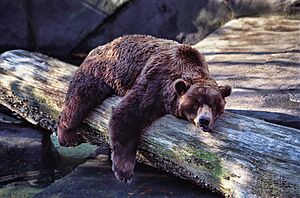
The Northern Passage is home to grizzly bears, a North American porcupine, and a rescued bald eagle. This exhibit opened in 2003. Visitors can see the bears from underwater viewing areas or from the windows of a large Tundra Buggy.
This exhibit used to have polar bears. One famous polar bear named Magnet lived here. He was born in 1988 and was very popular. Magnet passed away in 2015 due to kidney disease.
In March 2017, two rescued grizzly bear cubs, Nova and Nita, came to live at the Northern Passage. The polar and grizzly bears used to switch between exhibits. As of November 2021, polar bears are no longer at the zoo, and the exhibit is now called the Northern Passage.
Penguin Coast
The Zoo’s amazing African penguin exhibit, called Penguin Coast, opened on September 27, 2014. It lets you get very close to nearly 60 African black-footed penguins, white-breasted cormorants, and great white pelicans. The exhibit looks like their natural home along the coasts of South Africa. There's a special window to watch them swim underwater and a tidal pool that makes waves.
You can even watch the penguins get their daily fish during morning and afternoon feedings! Penguin Coast also has a building for education programs, animal demonstrations, and special events.
Conservation Efforts
The Maryland Zoo in Baltimore works hard to protect animals. They are involved in programs like "Polar Bears International" and "Project Golden Frog." They also have the largest group of African black-footed penguins in North America, thanks to their successful breeding program. The zoo also helps injured local wildlife, especially birds like bald eagles, get better.
Images for kids
-
A Red-and-green macaw at a keeper talk.
-
A Sitatunga (Tragelaphus spekii) eating grass.
-
Dama gazelle (Nanger dama).


